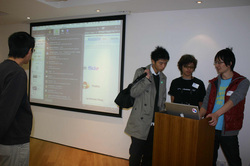 Students who want to learn English online can practice their presentations via screen share on Skype. Students who want to learn English online can practice their presentations via screen share on Skype. Students who have a good understanding of basic vocabulary and grammar structures in English are ready to present to audiences. Intermediate to advanced level students will benefit from learning how to give speeches and presentations. This skill is important especially in the business world in which a presentation can also be simply stating your opinion on a certain topic. Prepare your students for giving presentations by teaching them the vocabulary necessary to smoothly start and finish their presentations as well as how to move forward during it. Giving opinions and assessments are also part of making presentations. Teach your students vocabulary related to this topic as well. Vocabulary List This list of vocabulary and sentences for making presentations will help your students give more seamless presentations: -Good afternoon, ladies and gentlemen. My name is. . ., and we will be talking about. . .today. -Thank you for having me today. I’d like to get started by saying that. . . -If you have any questions, please feel free to raise your hand during the presentation and ask. -We will have a time for questions at the end of the presentation. -Let’s move on to the next topic. -The next point is that. . . -Moreover / However / In contrast (to) / Additionally (and other transition words and phrases) I believe that. . . I disagree because. . . I think you’re right. I don't think that's correct / right. I agree with. . . I respectfully disagree. I disagree in part because. . . We will talk about that shortly. Trend From (date) to (date), we experienced / saw a rise (fall) in. . . Increasing / decreasing / rose or fell sharply (and other words to describe graphs) First / second / last / finally / in conclusion Thank you for your time, and have a good day. This concludes my presentation. Family Talking about students’ families is just one of many topic ideas for presentations. Topics for ESL students should not generate anxiety in your students. Choosing a topic with which they are familiar and for which they do not have to do much research is especially appropriate for intermediate or low-advanced level students. Family is something almost all students are familiar with in the upper level classes. They may learn some new family member vocabulary as they put together their presentations. Encourage your students to use words related to family throughout their presentations. Give students a page or time limit to keep their speeches manageable. Customs Have students pick one custom from their countries they want the class to know more about. They may need to do some research to know more about the background and history of the custom. This aspect of this topic makes it more appropriate for more advanced students. Tell students to provide a picture or a PowerPoint presentation (provided your classroom is equipped for them) to provide a visual reference for students in the audience. They might also dress up or do a demonstration of the custom. Business Provide hypothetical line or bar graphs or pie charts to your students. Split the class up into a few groups, each with a different graph or chart. The job of each group is to describe the trend on the graph, provide background information for why the trend is what it is, and to give ideas to improve the trend, if necessary. They might also provide ideas to build on the current success of the company. Each person in the group can address a different aspect of the trend. This gives students a taste of what presenting as part of a team in a business environment might be like. Tips Many students will naturally be nervous about giving presentations. Topics for ESL students that speak to what they already know or are easy to research help them concentrate on learning the essential vocabulary of giving a presentation. Giving a presentation is also about style and knowing the customs of the country in which the presenter is speaking. Students have to think about not reading from their note cards, injecting humor into their presentations, keeping to a time limit, providing relevant visuals, and other behaviors that do not necessarily involve learning vocabulary and grammar. Vocabulary and grammar are also integral to giving a presentation, however. So, choosing topics for your students that let them focus on mastering vocabulary and grammar when making a presentation will help them become more effective presenters. Finally, students should practice giving presentations more than once to their classmates and to native English speakers. As they gain confidence, bring in a small audience of native English speakers to the classroom and have students prepare a presentation for them. This may be more appropriate for business English learners and more advanced students.
0 Comments
Leave a Reply. |
AuthorLeyla Norman Archives
July 2020
Categories
All
|

 RSS Feed
RSS Feed
